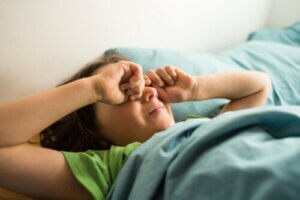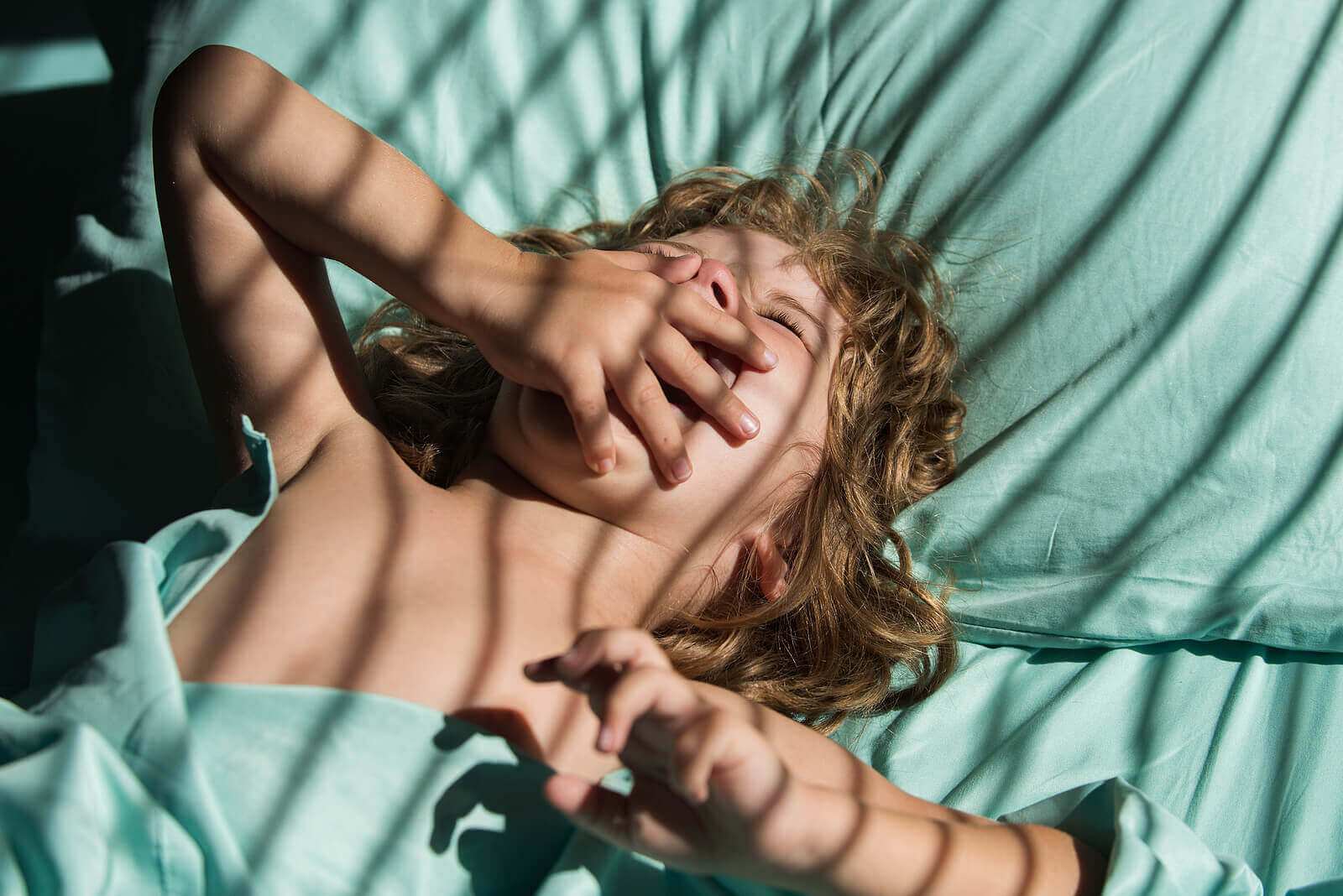What Is Confusional Arousal in Children

Some parents have a really hard time getting their children to go to bed at night. Some children are anxious and find it hard to fall asleep and wake up in the morning, and some children even wake up disoriented. This may be due to the disorder known as “confusional arousal” which we’ll discuss below.
When a child wakes up as if they were still sleeping, they may suffer from this disorder. According to the University of Granada-Grupo Lo Mónaco, about 17% of children suffer from it occasionally or frequently.

What is confusional arousal and at what age does it appear?
Confusional arousal is a disorder that appears when a person wakes up and remains very disoriented for several minutes. They’re unable to respond to external stimuli and some of their mental faculties are diminished.
It can appear at any age, even in adulthood, but it appears more commonly between the ages of 3 and 13. The latest research from the University of Granada, as we said, states that around 17% of children suffer from this disorder.
What are the symptoms of sleep drunkenness?
These episodes of disorientation appear more frequently when children are woken up earlier than usual. Some characteristic symptoms include the following:
- Mental confusion.
- Spatial and temporal disorientation.
- Memory failures.
- In some cases, moments of amnesia (total or partial).
- The appearance of abnormal behavior, such as screaming, crying or even trying to hit.
These symptoms tend to appear especially when the child wakes up in the middle of a deep sleep phase or when they wake up after having slept all night.
What can you do if you notice symptoms in your child?
One of the main factors of the appearance of confusional arousal in children and adolescents is a delay in sleep schedules. In the morning, when they wake up to go to school, they’re still in the deep sleep phase. Therefore, their brain is still asleep and needs some time to activate itself.
Waking children progressively, exposing them to natural light, and preventing them from using electronic devices at night are three measures that can be effective in treating this disorder. If this disorder persists and doesn’t improve, it’s best to consult a doctor.
Does confusional arousal have consequences in child development?
This disorder doesn’t usually have negative consequences and isn’t considered serious. What’s more, it normally disappears as a child gets older. As long as it occurs occasionally, it doesn’t negatively impact a child’s development. However, if it appears on a frequent basis, then a doctor will have to determine what the cause is.
What does treatment involve?
By following proper sleep hygiene norms and a series of recommendations, the disorder may disappear. During the REM phase is when children tend to have spontaneous awakenings and where the most intense dreams appear.
If your child usually goes to bed late and experiences a lack of sleep all week, when you force them to wake up in the morning, you may be interrupting the deep sleep phase. As a result, they may experience confusional arousal.

Recommendations for parents of children with confusional arousal
When this disorder appears frequently in children, then it’s important to consult with a doctor to determine the cause of its appearance. This disorder is closely related to stress and anxiety at the time they’re going to sleep. For this reason, experts recommend following certain sleep hygiene norms, such as the following:
- Practice sports on a daily basis: This physical activity should never take place within 3 hours of going to bed. Otherwise, rather than being beneficial to sleep habits, it will end up making it harder for your child to fall asleep. This is due to the release of endorphins during exercise.
- Avoid abundant and late dinners: Children should have a light dinner and eat it early so that digestion doesn’t make it difficult for them to sleep.
- Exposure to daylight when they wake up: This favors the synchronization of sleep with the day-night cycle.
- Avoid the use of electronic devices and watching stimulating shows and movies before going to sleep. Don’t forget that there shouldn’t be any cell phone in your child’s or teenager’s room unless it’s turned off. This is because the vibration or sound could produce sleep fragmentation, which reduces sleep quality.
In short, confusional arousal is a benign disorder in children that usually disappears with age. It’s important to remember that, if it appears frequently, you should consult a doctor to determine the cause of this alteration.
Now you know something more about this alteration and the recommendations that you can follow so that the situation improves. You just have to put them into action so that your child can have a good night’s sleep.
Some parents have a really hard time getting their children to go to bed at night. Some children are anxious and find it hard to fall asleep and wake up in the morning, and some children even wake up disoriented. This may be due to the disorder known as “confusional arousal” which we’ll discuss below.
When a child wakes up as if they were still sleeping, they may suffer from this disorder. According to the University of Granada-Grupo Lo Mónaco, about 17% of children suffer from it occasionally or frequently.

What is confusional arousal and at what age does it appear?
Confusional arousal is a disorder that appears when a person wakes up and remains very disoriented for several minutes. They’re unable to respond to external stimuli and some of their mental faculties are diminished.
It can appear at any age, even in adulthood, but it appears more commonly between the ages of 3 and 13. The latest research from the University of Granada, as we said, states that around 17% of children suffer from this disorder.
What are the symptoms of sleep drunkenness?
These episodes of disorientation appear more frequently when children are woken up earlier than usual. Some characteristic symptoms include the following:
- Mental confusion.
- Spatial and temporal disorientation.
- Memory failures.
- In some cases, moments of amnesia (total or partial).
- The appearance of abnormal behavior, such as screaming, crying or even trying to hit.
These symptoms tend to appear especially when the child wakes up in the middle of a deep sleep phase or when they wake up after having slept all night.
What can you do if you notice symptoms in your child?
One of the main factors of the appearance of confusional arousal in children and adolescents is a delay in sleep schedules. In the morning, when they wake up to go to school, they’re still in the deep sleep phase. Therefore, their brain is still asleep and needs some time to activate itself.
Waking children progressively, exposing them to natural light, and preventing them from using electronic devices at night are three measures that can be effective in treating this disorder. If this disorder persists and doesn’t improve, it’s best to consult a doctor.
Does confusional arousal have consequences in child development?
This disorder doesn’t usually have negative consequences and isn’t considered serious. What’s more, it normally disappears as a child gets older. As long as it occurs occasionally, it doesn’t negatively impact a child’s development. However, if it appears on a frequent basis, then a doctor will have to determine what the cause is.
What does treatment involve?
By following proper sleep hygiene norms and a series of recommendations, the disorder may disappear. During the REM phase is when children tend to have spontaneous awakenings and where the most intense dreams appear.
If your child usually goes to bed late and experiences a lack of sleep all week, when you force them to wake up in the morning, you may be interrupting the deep sleep phase. As a result, they may experience confusional arousal.

Recommendations for parents of children with confusional arousal
When this disorder appears frequently in children, then it’s important to consult with a doctor to determine the cause of its appearance. This disorder is closely related to stress and anxiety at the time they’re going to sleep. For this reason, experts recommend following certain sleep hygiene norms, such as the following:
- Practice sports on a daily basis: This physical activity should never take place within 3 hours of going to bed. Otherwise, rather than being beneficial to sleep habits, it will end up making it harder for your child to fall asleep. This is due to the release of endorphins during exercise.
- Avoid abundant and late dinners: Children should have a light dinner and eat it early so that digestion doesn’t make it difficult for them to sleep.
- Exposure to daylight when they wake up: This favors the synchronization of sleep with the day-night cycle.
- Avoid the use of electronic devices and watching stimulating shows and movies before going to sleep. Don’t forget that there shouldn’t be any cell phone in your child’s or teenager’s room unless it’s turned off. This is because the vibration or sound could produce sleep fragmentation, which reduces sleep quality.
In short, confusional arousal is a benign disorder in children that usually disappears with age. It’s important to remember that, if it appears frequently, you should consult a doctor to determine the cause of this alteration.
Now you know something more about this alteration and the recommendations that you can follow so that the situation improves. You just have to put them into action so that your child can have a good night’s sleep.
All cited sources were thoroughly reviewed by our team to ensure their quality, reliability, currency, and validity. The bibliography of this article was considered reliable and of academic or scientific accuracy.
- Solari, B. F. (2015). Trastornos del sueño en la adolescencia. Revista Médica Clínica Las Condes, 26(1), 60-65. https://www.sciencedirect.com/science/article/pii/S0716864015000103
- Abad, R. S. C. Trastornos del sueño en la niñez. http://www.aeped.es/sites/default/files/documentos/34-sueno.pdf
- UGR. (2017). Un 17 % de los menores sufre ‘borrachera del sueño’. https://canal.ugr.es/noticia/17-los-menores-sufre-borrachera-del-sueno/
This text is provided for informational purposes only and does not replace consultation with a professional. If in doubt, consult your specialist.








